Background: Botulinum toxin type A (BoNT-A) primarily acts by inhibiting the release of acetylcholine from the presynaptic terminal, resulting in reversible chemical paralysis of muscles. It is a widely accepted treatment for improving the appearance of glabellar expression lines that develop due to muscle contraction.
Method: The glabellar force patterns, facial wrinkle classification, and a number of BoNT-A units used in the corrugator and procerus muscles were evaluated.
Results: The mean total units of BoNT-A used were 7.2U in the corrugator muscle (7.1U in women and 7.4U in men) and 3.9U in the procerus muscle (3.9U in women and 4.1U in men), with a positive correlation between the number of units used and the age of the 58 participants. Regarding muscle strength pattern, more units were used in the corrugator muscle with a strong pattern and facial wrinkle classification of 3-4 and moderate with the same wrinkle classification (8U and 8.5U, respectively). In the procerus muscle, more units were used in the strong force pattern with wrinkles classified as 3-4 (5U). Wrinkles classified as 3-5 required the highest number of BoNT-A units.
Conclusion: The quantity of BoNT-A units used is directly proportional to the strength pattern and classification of facial wrinkles, with more units required when a strong force pattern and deep wrinkle classification are observed.
Keywords: Botulinum toxin type A, Rosacea, Muscle facial, Skin aging, Dermatology
The first report in the history of Botulinum Toxin (BoNT) was described by the German physician Justinus Kerner, who in the 18th century described botulism for the first time, based on the observation of deaths in Germany after ingesting blood sausages, a traditional preserved food from the region, which was contaminated.1,2 Van Ermengem isolated and described Clostridium Botulinum, an anaerobic bacterium that causes botulism, in 1897 through histological sections. From then on, investigations were conducted to understand the relationship between the disease and the toxin and its structural characterization and mechanism of action.3,4
The BoNT molecule comprises a light chain (50 kDa) and a heavy chain (100 kDa), joined by disulfide bridges, surrounded by hemagglutinins.5,6 The mechanism by which BoNT acts, leading to muscle paralysis, occurs when the hemagglutinin touches the terminal axon, causing the heavy chain to connect with the receptor in the axon. This facilitates the passage and the molecule can enter the neuron. The chains then disconnect, and the light chain cleaves the SNARE complex, removing part of its structure, SNAP-25. Therefore, the SNARE complex, which would be responsible for the passage of acetylcholine into the synaptic cleft, is unable to perform its function, preventing the depolarization of the cell membrane and the influx of calcium and efflux of sodium, making muscle contraction of actin and myosin fibers impossible.5-7
Ophthalmologist Alan B. Scoth of the Eye Research Institute in San Francisco, California (1920) described the medicinal use of BoNT in patients with ocular misalignment in cases of strabismus.3,4 Injection of this toxin resulted in a reduction in muscle activity through chemical denervation.8 Since then, other indications have appeared, including treatment of dynamic wrinkles, axillary hyperhidrosis, and blepharospasm.9,10 BoNT was only approved in 1989 by the Food and Drug Administration (FDA) as a therapy for muscular disorders, and later, in 2002, it was approved for aesthetic purposes.5,7
Evidence of aging through expression lines in the glabellar region occurs due to the synergistic contraction of the corrugator, depressor, and/or procerus muscles, resulting in “frontal furrows” particularly between the eyebrows. Due to the constant contraction of the glabellar muscle complex, dynamic wrinkles are formed and evolve into static wrinkles, which are more pronounced and noticeable at rest. Their presence can often be perceived as a sign of aging and can erroneously give the impression of emotions such as anger or sadness.11
Botulinum toxin type A (BoNT-A) is a widely accepted treatment for improving the appearance of glabellar lines.12 Furthermore, it is a treatment that generates great patient satisfaction since the aesthetics of the glabellar lines impact psychological well-being, self-confidence, and quality of life13,14 even though BoNT-A may have some contraindications such as the presence of keloids, neuromuscular diseases, body dysmorphic disorders and allergies to some component of the substance.14,15
In this article, we establish the relationship between muscle strength, facial wrinkle classification, and the number of botulinum toxin type-A units to obtain satisfactory results in treating glabellar expression lines.
The protocol and use of the material, as well as all procedures of this research, were submitted to and approved by the Research Ethics Committee of the Institute of Health and Well-being of Women - ISBEM (CEP 6.849.192). Fifty-eight patients were randomly invited to the study at the Pithon Napoli Aesthetics Clinic in São Paulo from December 2023 to April 2024. All patients received information about the procedures and guidance regarding this research from the team's physicians. After being informed and clarifying any doubts, the informed consent form (ICF) was signed. All patients who disagreed with the development of the study and refused to sign the ICF were excluded, as well as patients vaccinated with tetanus or any chemical peel in the last six months who underwent procedures that could affect the forehead and glabellar regions in the previous 12 months, autoimmune disease and/or current use of medications that act on the neuromuscular junctions.
The study was conducted with male and female patients who sought the clinic, stating they wanted to undergo the glabellar line filling procedure using BoNT-A. The participants were divided into two groups according to age: between 20-39 (36 participants) and 40-60 years (21 participants), and were evaluated according to the following parameters: description of the glabellar force pattern, classification of facial wrinkles and number of BoNT-A units used in the corrugator and procerus muscles Study Design - Figure 1.
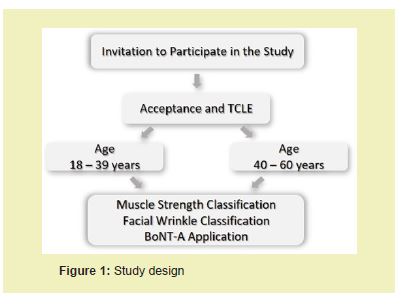
Muscle strength classification
The classification of muscle strength (corrugator and procerus muscles) was performed according to the authors' designation, with the participant being asked to perform the "angry face" mimic Figure 2, with which he was classified into three strength levels: Strong pattern, where the corrugator and procerus muscles are well defined with medial formation of very evident dermal fractures; Moderate pattern, which presents well-defined muscles reproducing less central force during the mimic and consequently, less evident dermal fractures; and Weak pattern, where the limits of the glabellar muscles are not observed, mainly of the corrugators, with less formation of intense dermal fractures and expression lines.
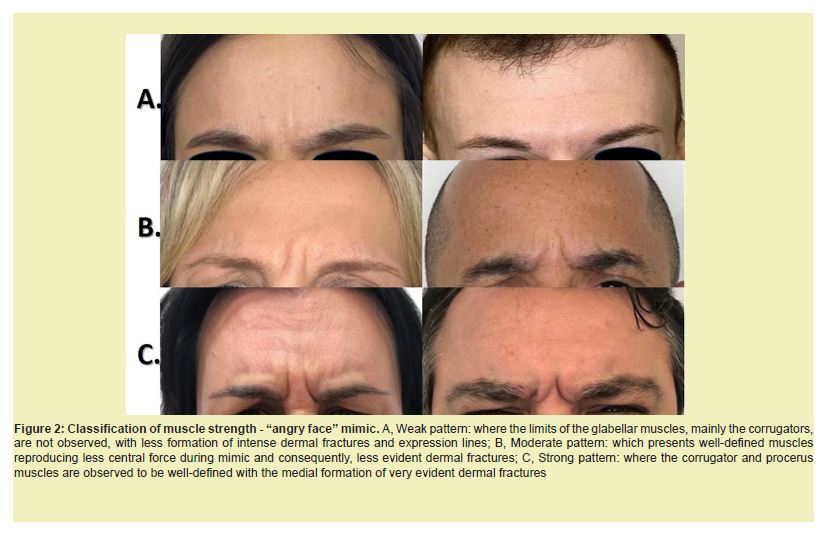
Classification of facial wrinkles
Wrinkles were determined according to Lemperle 2001,11 where the six-point photonumeric rating scale in which the degree of wrinkle in the reference photographs was compared with the wrinkle on the participant's face was used. All participants were photographed (iPhone 12 pro and Quantificare camera) for photo documentation and evaluation. The classification, according to Lemperle, is presented in Table 1.
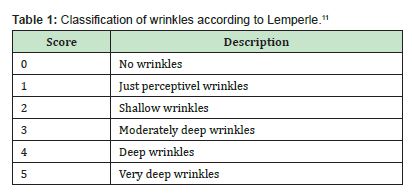
BoNT-A Application
For this procedure, botulinum toxin type A - Botulift® (Bergamo Farmacêutica - Medytox Inc, Cheongwongu, South Korea) was used and applied intramuscularly with a 50 or 30 IU pediatric BD syringe in the glabellar line region. Table 2 shows the maximum number of BoNT-A units that could be applied to each muscle, and Figure 3 is a visual representation of each muscle. The number of units applied was based on the strength and facial wrinkle classification assessment, with Botulift applied on day “0” and reassessed on day “15-30”. The procedure did not require the use of anesthetics. The participant was instructed by the professional to use the analgesic medication - dipyrone 1g or paracetamol 725mg every 6 hours - in case of pain. We do not recommend using anti-inflammatories or corticosteroids in case of discomfort/pain in the application region. The effect of Botulift® begins approximately 48 to 72 hours after application and has its maximum effect approximately 1 to 4 weeks after application. O efeito da aplicação (relaxamento do músculo e diminuição da contração excessiva) geralmente perdura por um período de 3 a 4 meses.
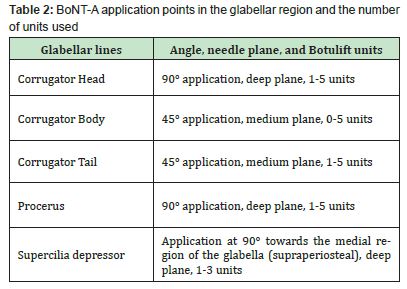
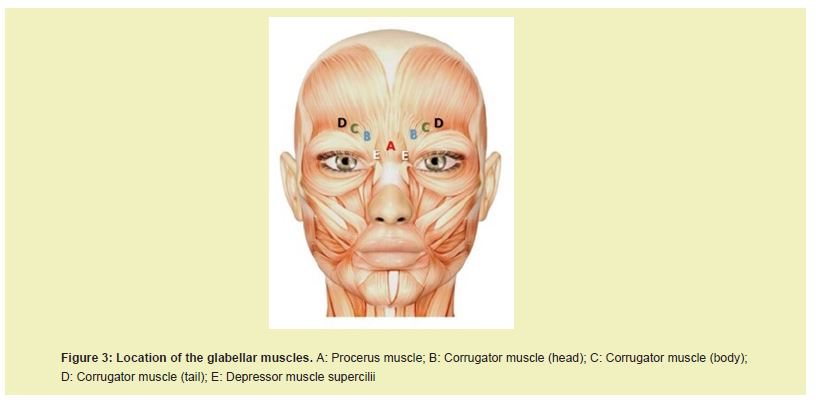
Data analysis
Categorical variables were expressed as absolute counts and proportions and compared using the chi-square test. Continuous variables were presented as medians and interquartile ranges and compared between groups using the Mann-Whitney test. We used Pearson's correlation to investigate the relationships between the frontalis muscles (corrugator and procerus) and the administered botulinum toxin A (BoNT-A) doses. The analyses were performed using the IBM SPSS v21 statistical program software. Values were considered statistically significant when p≤0.05. The values are expressed as mean ± SD.
The age for the first application of BonT-A was 35 for both men and women; 28% of the participants were male, 72% were female, and the average overall age was 38. Among men, the average was 36 (ranging from 27 to 54 years), with approximately 80% of the patients under 40. Among women, the average age was 38 (ranging from 23 to 68), and 70% were under 40.
The mean number of BoNT-A units used was 7.2 in the corrugator and 3.9 in the procerus muscle. When separated by sex, the mean in the corrugator was 7.1 for females and 7.4 for males. The procerus's mean was 3.9 for females and 4.1 for males. From linear regressions, we were able to observe that there is a positive association between the number of units used and the age of the patients, both in the corrugator (r²=0.30; p˂0.05; Figure 4A) and in the procerus muscle (r²=0.30; p˂0.05; Figure 4B), this suggests that due to the greater degree of classification of facial wrinkles, the more suggestive the need for units for more significant paralysis, and consequently, better results.
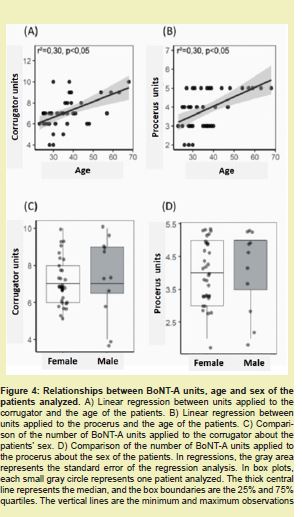
When analyzing the BoNT-A units applied to the participants' sex, we did not observe any difference between men and women in the corrugator muscle (p=0.42; Figure 4C) or the procerus (p=0.51; Figure 4D).
When the degree of corrugator strength was weak, with facial wrinkle classification between 1-2, an average of 6 IU was required in the muscles. On average, 3.5 IU was needed in the head, 0.5 IU in the body, and 2 IU in the tail of the corrugator. When the corrugator strength pattern was moderate, with facial wrinkle classification between 0-2, an average of approximately 7 IU was required in the muscles. On average, 3.75 IU was applied to the head, 0.9 IU to the body, and 2.3 IU to the corrugator's tail. It still had a moderate force pattern, but with facial wrinkle classification between 3-4, the average was 8 IU. Of these, an average of 4.7 IU was applied to the head, 1 IU was applied to the body and 2.33 IU was applied to the tail of the corrugator.
The strong strength pattern of the corrugator, with facial wrinkle classification between 1-2, required an average of 7.2 IU. Of these, an average of 4 IU was applied to the head, 1.1 IU to the body and 2.1 IU to the tail of the corrugator. Still, with the strong strength pattern, but with facial wrinkle classification between 3-4, an average of 8.5 IU was required. Of these, an average of 4.5 IU was applied to the head, 0.75 IU to the body, and 3.25 IU to the tail of the corrugator. When the strength pattern in the procerus was weak, with facial wrinkle classification between 0-2, an average of 3.37 IU was required. It still had a weak strength pattern, but with a facial wrinkle classification of 3, 4 IU was needed. When the strength pattern was moderate, with facial wrinkle classification between 0-2, an average of 3.5 IU was required in the muscles. It still has a moderate pattern, but with facial wrinkle classification between 3-4, an average of 4.25 IU was needed. The muscular strength pattern of the procerus, with facial wrinkle classification between 1-2, required an average of 4.9 IU. With facial wrinkle classification between 3-5, an average of 5 IU was needed in the muscles.
When comparing the number of BoNT-A units required in the corrugator and procerus muscles, we found a significant difference, with more units needed in the corrugator than in the procerus (p<0.01; Figure 5).

In the corrugator, when comparing the units used in the groups with different strength patterns, we observed a significant difference between them (F2,42=4.11; p=0.02). After the Tukey test, we observed that there was a significant difference only between the “Strong” and “Weak” groups, with more units being required in the “Strong” group (p<0.05; Figure 6A). We also observed significant differences in the procerus when the groups were compared together (X²=20.04; g.l=2; p<0.05; Figure 6B). Separately, the “Strong” group differed both from the group with the “Weak” strength pattern and from the group with the “Moderate” pattern (p<0.05).
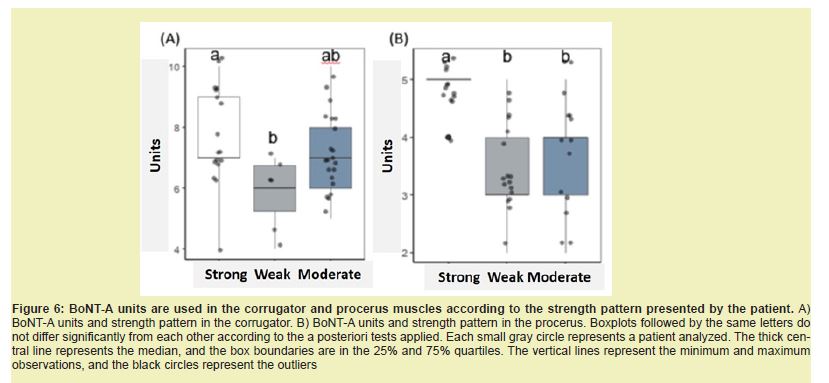
We observed a significant difference in the BoNT-A units used in both muscles between the groups with facial wrinkle scores of 0 to 2 and 3 to 5. In both muscles, the group with facial wrinkle scores of 3 to 5 required more BoNT-A units when compared to the group with facial wrinkle scores of 0 to 2 (corrugator: t=-2.72; d.f.=42; p<0.05; Figure 7A. Procerus: p<0.05; Figure 7B).
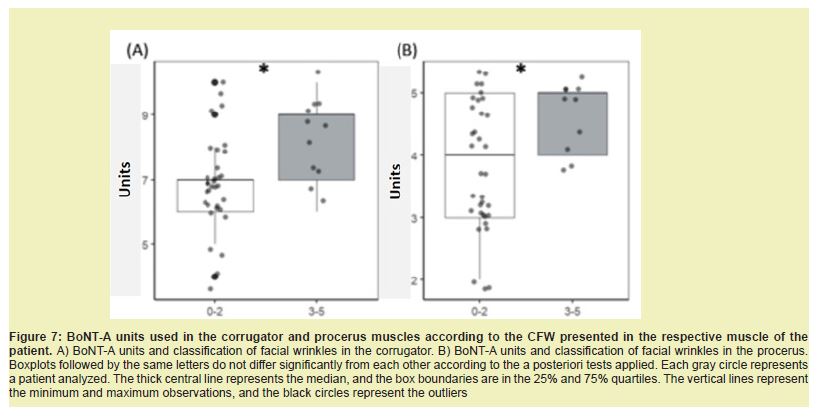
The age of the first application of BoNT-A is equivalent for men and women at 35 years of age, with women seeking the procedure twice as often as men but generally requiring the application of fewer BoNT-A units than men. The number of units used in the corrugator muscle is higher than observed in the procerus muscle, and these amounts in both muscles increase proportionally compared to the age of the participants. The evaluation of the “strong pattern” of strength in the corrugator and procerus muscles was the most evident, with the need to use more units of BoNT-A. Finally, the classification of facial wrinkles that required the most units of BoNT-A in the corrugator and procerus muscles were those classified as 3-5.
The glabella is the first area to be noticed in facial expression. Its contraction is associated with negative emotions, such as impatience, anger, and fatigue, which the individual often expresses unwantedly way.16 The main muscles that form the glabellar complex include the corrugator and orbicularis palpebral (approximate and depress the eyebrows), the procerus and depressor brows (depress), and the inferior fibers of the frontalis (elevate the eyebrows). Muscle activity causes hyperkinetic lines perpendicular to the direction of muscle contraction, forming unwanted horizontal, vertical, and oblique wrinkles.17
Some studies consider that glabellar lines act similarly in most individuals, with some differences between the sexes18-20 age, ethnicity,21,22 sun exposure, and differences related to physical activity.23,24 Our study observed a greater demand for the procedure among women of a wide range of ages, from the youngest to those considered elderly, aged over 60. Younger participants are encouraged to use BoNT-A as a preventative, while older participants use it to correct and/or maintain features acquired over time. Due to the period of muscle paralysis and relaxation, the skin (epidermis and dermis) regenerates, giving it a better appearance than before the application, leading to progressive muscle reduction and reeducation, improving skin texture in the long term.
A BoNT-A é administrada em unidades. A dose letal média é estimada entre 2.500 e 3.000 unidades para uma pessoa adulta de 70 kg. Embora a dose exata da toxina conhecida por causar toxicidade seja desconhecida, é geralmente aceito que doses únicas de BoNT-A não devem exceder 500 unidades.25 The number of points and units varies according to the needs of each patient. It is suggested that for longer duration and high patient satisfaction with the results of upper face treatment, the standard and ideal plan for applying botulinum toxin is to use a total of 64 units, combining standard treatment of the glabella in a ''U'' (ranging from 12 U to 40 U), frontal muscle treatment - total standard (ranging from 8 U to 25 U) and periorbital lines (ranging from 6 U to 15 U per side). Although this standard dosage is still commonly used and can serve as a guide for the novice injector, many physicians have begun to tailor injection points and dosage to each individual. Muscle strength, anatomy (rhytid pattern), basal asymmetries, and the patient's wishes should be considered when deciding the dose and injection pattern.26
According to some studies, glabellar frown lines should be treated with multiple injections of high doses of low volumes of BoNT-A, which allows precise placement of the toxin with little spread to non-target areas. Two double-blind, multicenter, controlled studies used 4 U of BoNT-A at five injection sites: one in the procerus and two in each corrugator, bilaterally. These injections demonstrated adequate results in most patients, while transient adverse effects were rare.27-29 Our study, as well as the literature, indicates that the muscle that requires the use of more units is the corrugator, and through our methodology, we also found that these quantities are dependent on the strength classification and facial wrinkles. Patients with greater strength demonstrated more prominent frontal lines in relation to muscle movement in the region and more significant deepening of the same lines. This makes it necessary to address the regions with the largest number of units and distribution points for the total or partial paralysis effect to obtain a natural impact on the target region. Our team suggests that the BoNT-A dilution be wet. That is, a toxin of 200 IU is diluted in 4 mL of saline solution. This way, we can distribute it to more points, influencing the force vectors that more efficiently contemplate the orbital forehead region.
Treatments with more individualized approaches have been published more recently. de Sanctis Pecora30 carried out a blind study to evaluate 130 women with moderate or severe glabellar wrinkles, using standard treatment with 5 injection points (4U per point) and the One21 therapy with an individualized and customized approach regarding distribution and dosage at the points. They showed that incobotulinumtoxin-A effectively reduced dynamic glabellar lines in all participants. Notably, individualized assessment and treatment with the One21 technique resulted in improved performance, achieving significantly higher efficacy rates than the standard 5-point treatment in the treatment of mild, moderate, and severe glabellar wrinkles, especially for asymmetrical glabella lines or involvement of muscle groups other than the procerus and corrugator.30 In our individual experience, we have observed that the more points distributed and the smaller the BoNT-A units per point, the more natural the result, maintaining movement and preventing the appearance of lines. Our patients report satisfactory and long-lasting results after four months.
Knowledge of the target regional anatomy, followed by a precise injection technique involving appropriate dose and injection depth, is essential to improve results and avoid complications.30 BoNT-A injection requires an adequate understanding of facial muscles' anatomical shape and insertion to guide objective muscle identification, resulting in a more practical approach. Our team undergoes constant updates and is dedicated to scientific studies to bring the most modern and valuable techniques to improve and provide the best patient results.
Our results reinforce the importance of an individualized evaluation with efficient methodologies to achieve the best outcome during the injection of BoNT-A for treating glabellar wrinkles. As a limitation of the present study, we observed the reduced use of technology. Today, the market offers cameras with 3D technology software that allow for a more qualified evaluation of the images, which would improve the assessment of the relationship and direction of the muscle force vectors before and after the application of BoNT-A. We will already have this more objective evaluation of the images for our following studies.
The number of botulinum toxin-A units used is directly proportional to the strength pattern and classification of facial wrinkles, and more BoNT-A units are necessary when the strong strength pattern and classification of deep wrinkles are observed, ensuring customer satisfaction with the methodology used. BoNT-A has excellent results in treating wrinkles and is also a fantastic treatment to prevent the evolution of shallow wrinkles into deep and/or static wrinkles, in addition to preventing aging.
JVMPN: conceptualization, methodology, execution, writing, review. GDM: methodology, execution, writing, review & editing. RCC: execution, writing, review & editing. MPM: statistical analysis, writing, review. All authors approved the final version of the article.
Pithon Napoli Clinic.
This study was approved by the Research Ethics Committee of the Institute of Health and Well-being of Women - ISBEM (CEP 6.849.192).
This Research Article received no external funding.
Regarding the publication of this article, the authors declare they have no conflict of interest.
- 1. Guerra Neto P. Toxina botulínica tipo A: ações farmacológicas e riscos do uso nos procedimentos estéticos faciais. Recife: Instituto Nacional de Ensino Superior e Pesquisa, Centro de Capacitação Educaional. 2016.
- 2. Colhado OC, Boeing M, Ortega LB. Botulinum toxin in pain treatment. Rev Bras Anestesiol. 2009;59(3):366-381.
- 3. Costa FHR. A toxina botulínica: histórico, fisiopatologia e indicações. Rio de Janeiro. 2020.
- 4. Dressler D, Roggenkaemper P. A brief history of neurological botulinum toxin therapy in Germany. J Neural Transm (Vienna). 2017;124(10):1217-1221.
- 5. de Oliveira CCA, Fernandes EC, Medeiros KDO, et al. Toxina botulínica: contexto histórico, molecular e de aplicação prática na área da saúde. Revista Brasileira De Educação E Saúde. 2020;10:1-10.
- 6. Drinovac Vlah V, Bach Rojecky L. Botulinum toxin type A: Basic pharmacological profile and therapeutic application. Arh farm. 2020;70:10-19.
- 7. Sposito MMdM. Toxina Botulínica do Tipo A: mecanismo de ação. Acta Fisiátr. 2009;16(1):25-37.
- 8. Gouveia BN, Ferreira LdLP, Rocha Sobrinho HM. O uso da toxina botulínica em procedimentos estéticos. Revista Brasileira Militar De Ciências. 2020;6:56-66.
- 9. Costa A, Talarico Filho S, Arruda LH, et al. Estudo clínico multicêntrico, prospectivo, comparativo, randomizado e duplo cego, entre duas formulações de toxina botulínica tipo A registradas no Brasil para o tratamento das rugas da glabela. Surgical & Cosmetic Dermatology. 2016;8:33-40.
- 10. Gimenez R, Pinto. Análise retrospectiva das alterações da dinâmica facial após aplicações seriadas de toxina botulínica tipo A. São Paulo: Universidade São Paulo. 2007.
- 11. Lemperle G, Holmes RE, Cohen SR, et al. A classification of facial wrinkles. Plast Reconstr Surg. 2001;108(6):1735-1750.
- 12. Kaufman Janette J, Cox SE, Dayan S, et al. Botulinum Toxin Type A for Glabellar Frown Lines: What Impact of Higher Doses on Outcomes?. Toxins (Basel). 2021;13(7).
- 13. Benedetto AV. The cosmetic uses of Botulinum toxin type A. Int J Dermatol. 1999;38(9):641-655.
- 14. Allergan-BOTOX. Bula paciente. 2023.
- 15. Small R. Botulinum toxin injection for facial wrinkles. Am Fam Physician. 2014;90(3):168-175.
- 16. Lewis MB, Bowler PJ. Botulinum toxin cosmetic therapy correlates with a more positive mood. J Cosmet Dermatol. 2009;8(1):24-26.
- 17. Borba A, Matayoshi S, Rodrigues M. Avoiding Complications on the Upper Face Treatment With Botulinum Toxin: A Practical Guide. Aesthetic Plast Surg. 2022;46(1):385-394.
- 18. Carruthers J, Fagien S, Matarasso SL, et al. Consensus recommendations on the use of botulinum toxin type a in facial aesthetics. Plast Reconstr Surg. 2004;114(6 Suppl):1S-22S.
- 19. Draelos ZD. The shrinking world: skin considerations in a global community. J Cosmet Dermatol. 2006;5(1):1-2.
- 20. Flynn TC. Botox in men. Dermatol Ther. 2007;20(6):407-413.
- 21. Porter JP, Lee JI. Facial analysis: maintaining ethnic balance. Facial Plast Surg Clin North Am. 2002;10(4):343-349.
- 22. Monheit G, Carruthers A, Brandt F, et al. A randomized, double-blind, placebo-controlled study of botulinum toxin type A for the treatment of glabellar lines: determination of optimal dose. Dermatol Surg. 2007;33(1 Spec No.):S51-S59.
- 23. Rexbye H, Petersen I, Johansens M, et al. Influence of environmental factors on facial ageing. Age Ageing. 2006;35(2):110-115.
- 24. de Almeida AR, da Costa Marques ER, Banegas R, et al. Glabellar contraction patterns: a tool to optimize botulinum toxin treatment. Dermatol Surg. 2012;38(9):1506-1515.
- 25. Sorensen EP, Urman C. Cosmetic complications: rare and serious events following botulinum toxin and soft tissue filler administration. J Drugs Dermatol. 2015;14(5):486-491.
- 26. Borba A, Matayoshi S. Facial rejuvenation techniques: botulinum toxin and MD Codes TM. 1st (edn) São Paulo - Brasil: Buzz Editor Ltda. 2018.
- 27. Carruthers A, Carruthers J. Botulinum toxin type A: history and current cosmetic use in the upper face. Semin Cutan Med Surg. 2001;20(2):71-84.
- 28. Carruthers JD, Lowe NJ, Menter MA, et al. Double-blind, placebo-controlled study of the safety and efficacy of botulinum toxin type A for patients with glabellar lines. Plast Reconstr Surg. 2003;112(4):1089-1098.
- 29. Carruthers JA, Lowe NJ, Menter MA, et al. A multicenter, double-blind, randomized, placebo-controlled study of the efficacy and safety of botulinum toxin type A in the treatment of glabellar lines. J Am Acad Dermatol. 2002;46(6):840-849.
- 30. de Sanctis Pecora C, Pinheiro MVB, Ventura Ferreira K, et al. The One21 Technique: An Individualized Treatment for Glabellar Lines Based on Clinical and Anatomical Landmarks. Clin Cosmet Investig Dermatol. 2021;14:97-105.

